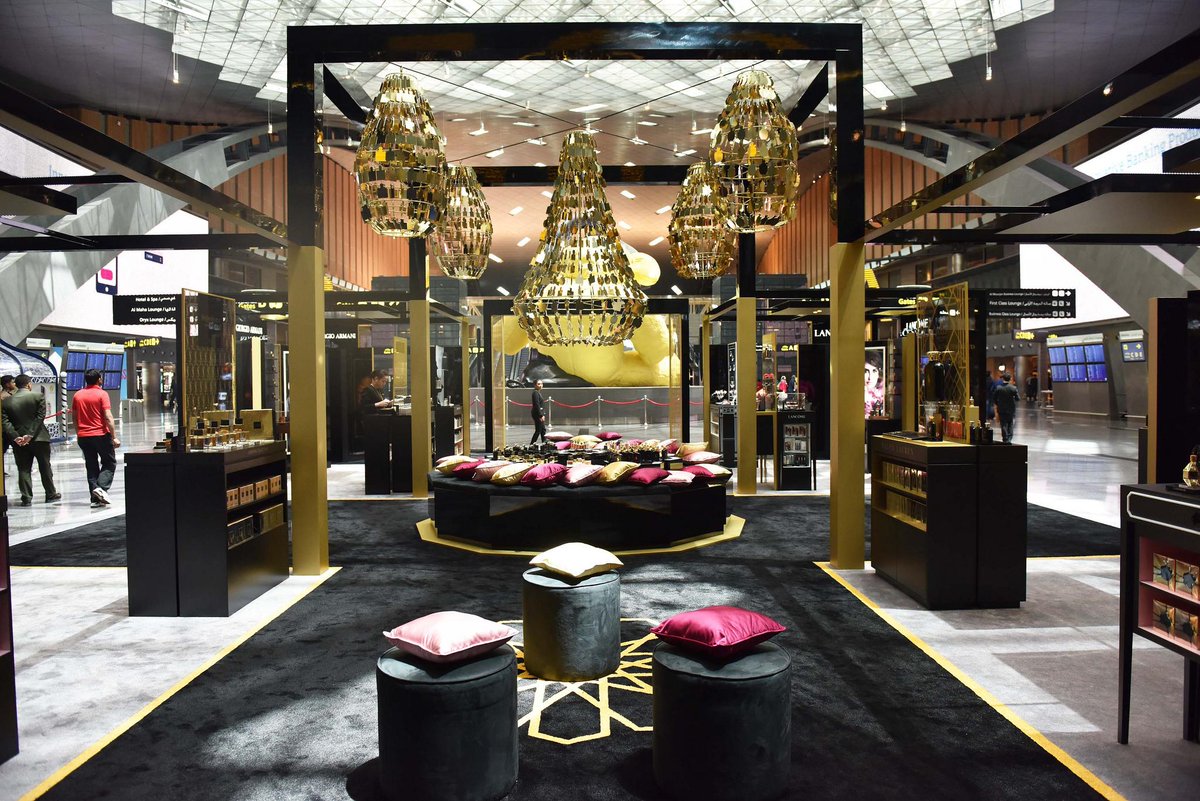@qatardutyfree entices with sensory roller-coaster at @HIAQatar... #luxurymenaluxury.com/latest-news/tr
Branded spaces in airports
Why are branded environments taking off in airports?
These days, it might seem like online marketing and e-commerce are the hallmarks of retail’s future. However, companies are always exploring promising prospects for reaching customers in the ‘real’ world as well, and airports might just be one of the biggest opportunities out there.
For that reason, we’re seeing the growth of branded environments in airport terminals, as companies take advantage of a relatively captive audience and create displays intended to attract their attention (and dollars) while adding to the overall travelling experience.
Why are airports the place to be?
A number of factors are contributing to the rapid growth of air travel, with figures from the International Air Travel Association (IATA) showing that demand for flights rose 5.9
A record 3.3 billion people boarded flights in 2014.
As those of us who have travelled know (perhaps all too well), passengers don’t simply pass through airports, though. Typically, there’s a fair amount of wait time between getting through security and boarding the aeroplane. And that’s where the opportunity lies for retailers and their branded environments.
Just how much time do people usually spend in terminals? It varies depending on the location, destination and whether it’s an international or domestic flight, but it can range from a few minutes to well over an hour – more for layovers and international flights.
As an example, the Queensland University of Technology examined passenger behaviour at two international airports in Australia in 2012. On average, travellers spend 40 minutes and 14 seconds on the landside of the airport terminal, amounting to almost one-third of their total airport dwell time. Although half of the overall time spent in the airport was focussed on processing activities (such as ticketing and security), that left about 45

It’s not just the fact that this captive audience is probably looking for something to do that makes airports a high-potential commercial location. As Glen Wilson recently wrote on LinkedIn, air travellers are a special type of consumer, often experiencing a sense of accomplishment and having a level of expendable income that makes them prone to purchase gifts, interact with luxury brands and want to explore ‘exotic’ products.
What’s the future of retail in terminals?
For these reasons, airports are already showing themselves to be promising retail environments. In 2014, The Economist called airports the ‘sixth continent’, referring to L’Oreal’s attitude and the fact that for many brands, the venue is one of the most important markets. In addition to bringing in the sales, these spaces also give companies the chance to feel out their potential marketing to particular demographics, while spreading their brand image as travellers take their goods all over the world.
The Economist collated a number of statistics that point to the growing potential of airport terminals:
- Duty-free sales have grown over 12
percent annually since 2009. - Travel retailers sold about US$60 billion worth of goods (data from Generation Research).
- Verdict Retail expects airport sales to grow 73
percent from 2013 to 2019. - Asia’s airports outsold Europe’s by more than 100
percent by 2016.
Clearly, terminals provide an incredibly lucrative retail space and an excellent platform for brands to get their name out there and interact with a seemingly warm audience.
How do branded environments help companies stand out?
Branded environments transform simple spaces into immersive experiences.
Both airports and the companies that utilise their open terminal spaces have a vested interest in creating more than just a simple shopping stand. Instead, with airports looking to enhance the overall travel experience and organisations competing to make a memorable impression while attracting interest, brands are looking to create enticing, rich displays.
That’s where branded environments come in, transforming a simple place into an immersive experience that both conveys the enterprise’s image and provides a pleasant encounter for customers. As Hospitality Net recently argued, “airports are the new malls” and they’re shifting from simple souvenirs and newsstands to luxury shopping and brand experiences.
The Economist noted some of these developments, calling attention to Qatar’s airport which included a ‘stunning’ terminal bursting with restaurants, shops and even a ‘uniquely shaped mosque’. In Heathrow, World Duty-Free Group utilises technology to ensure staff leverage the right technique based on cultural sensitivities, such as national tastes and shopping habits. That way, they can adjust their displays and actions based on which flights are coming in or going out, the magazine added.
Branded environments cater to the audience at hand while reinforcing and building a company’s image. Colour, technology, lines, shapes, music and lighting all come into play, as do displays where customers can see or try out products and offerings. These bolster associations and emotional connections while enticing shoppers to come in and spend. In short, it’s not just about using airport terminals to make sales, but as platforms to build brand awareness.
Given the audience, that’s a fantastic way to spread your message around the entire world.

